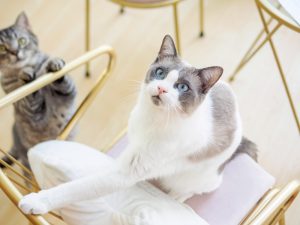Cat Behavior: Enrichment Activities for Indoor Cats
Cat Behavior: Enrichment Activities for Indoor Cats

Some cat owners grapple with the decision to restrict their cat’s exposure to the outside world. Many cats face early mortality or life-threatening injuries each year, so keeping them on the right side of the threshold is the safest choice. However, despite the fact that an indoor-only lifestyle is for their own good, it can feel like you’re limiting their opportunities for happiness. Luckily, with a little creativity and commitment, you can still keep them safe and cater to their needs.
It’s Innate
To fully understand cat behavior, we have to examine their body language. Look at how they groom themselves, communicate, eat, go to the bathroom, mark their territory, and most importantly, how they play.
Cats enjoy stalking, pouncing, climbing, perching, hiding, ambushing, chasing, and other instinctual predatory behaviors. When thinking of options for indoor enrichment, providing opportunities for them to use these skills are critical.
Easy as (Tuna) Pie
There are some pretty easy solutions to making your cat’s environment more friendly to their needs and desires. For example, a cat tree is a great addition to your home. Designed to stimulate their natural desire to scratch, stretch, jump, and climb, it also has little hiding places and comfy beds.
Alternatives to this type of household cat decor include bridges, climbing poles, shelves, and ramps. Giving them their own little hiding place can also make for a happier cat. Lastly, sleeping spots in the sun are always appreciated by any cat.
The Catio
If you have space in your backyard or off a window or door, consider installing a catio (cat patio). This is an enclosed play and lounge space that allows your cat the best of both worlds.
The Hunt is On
Most indoor-only cats have never had the chance to stalk and kill real prey, but they know exactly what to do when introduced to a toy mouse. Cat behavior hinges on their instinctual ability to hunt. Even a cat who doesn’t need to hunt for food can behave like quite the fearsome predator.
Toys that move quickly, squeak, or have their own sort of crunching noises are essential for feline play. Finding ones that mimic real prey are the best. In addition to mice, cats like toy birds (or feathers at the very least), bugs, lizards, and more. Just be sure these toys don’t cause any choking or GI blockages.
Keep Your Routine
Scheduled meal times and play breaks are important to indoor-only cats. They are, after all, creatures of habit who enjoy knowing what’s coming next. However, this doesn’t mean they don’t like the element of surprise during play.
Find different toys that stimulate their senses and rotate them in with older toys. Aim for frequent play times throughout the day, taking cues from your cat when they’re getting tired or bored. If they show continued interest, go for it!
Don’t Forget Catnip!
Coating your cat’s toys or stuffing them with catnip can trigger some zany behavior, like zipping around the house. Don’t be surprised if they start hiding under throw rugs, climbing the curtains, purring, and generally experiencing euphoria.
We Love Cat Behavior
Studies have proven that indoor-only cats live considerably longer than those who are allowed to roam. Of course, while it’s safer, this can definitely become dull. With our ideas for indoor enrichment, you can stimulate your cat’s behavior and keep everyone happy.
As always, please contact us with any questions or concerns. The team at Parkside Animal Hospital is always here for you and your cat!
